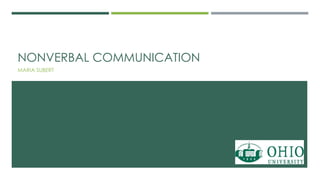
Understanding Nonverbal Communication
- 2. DEFINING NONVERBAL COMMUNICATION Nonverbal communication is the process of using wordless messages to generate meaning. Includes nonword vocalizations.
- 3. ELECTRONIC FORMS OF COMMUNICATION People who communicate through electronic forms of communication invented to communicate feelings and emotions by using emoticons.
- 4. MANY OF OUR FIRST IMPRESSIONS OCCUR NONVERBALLY
- 5. NONVERBAL COMMUNICATION WORK IN CONJUNCTION WITH THE WORDS By using them, we repeat emphasize complement contradict substitute our words and regulate our interactions with others.
- 6. REGULATING Regulating: using nonverbal codes to monitor and control our interactions, For example, you look away when someone is talking to you.
- 7. AMBIGUITY The ambiguity of non-verbal communication occurs for two reasons: First, the same code can communicate many meanings. (Touching the other’s nose mean different things between father and his baby, two lovers, or fighting teenagers.)
- 8. AMBIGUITY On the other hand, variety of codes can communicate the same meaning. (Think of the different forms of greetings.)
- 9. NONVERBAL CODES: Nonword vocalizations bodily movements facial expressions physical attraction use of space use of time Touch and clothing.
- 10. KINESICS Kinesics: the study of bodily movements such as posture gesture facial expressions.
- 11. LIKING We express liking by forward leaning direct body orientation close proximity increased touching relaxed posture open arms and body positive facial expression and direct eye contact.
- 12. STATUS High status is communicated by bigger gestures, relaxed posture, and less eye-contact.
- 13. RESPONSIVENESS Responsiveness: expressed by movement toward the other person, spontaneous gestures, shift in posture and position, and facial expressions.
- 14. MOVEMENT Eckman categorized movement as emblems, illustrators, affect displays, regulators and adaptors.
- 15. EMBLEMS & ILLUSTRATORS Emblems: nonverbal movements that substitute for words and phrases (such as beckoning first finger to mean “come here”) Illustrators: nonverbal movements that accompany or reinforce verbal messages (Shaking your fist when saying “Get out of here!”)
- 16. AFFECT DISPLAY & REGULATORS Affect display: nonverbal movements of the face and body used to show emotions. Regulators: movements that control the flow or pace of communication (looking away when you are not interested)
- 17. ADAPTORS Adaptors: Nonverbal movements that you might perform fully in private but only partially in public.
- 18. FACIAL EXPRESSIONS & BODILY MOVEMENT Facial expressions are important in conveying information to others and in learning how others are feeling. Bodily movement and orientation add to that information by suggesting how intense the feeling might be.
- 19. PHYSICALLY ATTRACTION People who are physically attractive are privileged over those who are not physically attractive. This bias is stronger for women that for men
- 20. PROXEMICS: THE STUDY OF HUMAN USE OF SPACE AND DISTANCE
- 21. TERRITORIALITY: Territoriality: the need to establish and maintain certain spaces as your own.
- 22. PERSONAL SPACE Personal space: the personal “bubble” that moves around with you. The distance you maintain between you and the others. Men tend to take more space, women less.
- 23. CHRONEMICS: TEMPORAL COMMUNICATION Chronemics: The way people organize and use time and the messages related to it. Monochromic people make one task at a time Polychronic people work on several tasks at a time
- 24. TACTILE COMMUNICATION Tactile communication is the use of touch in communication. Insufficient amount of touching can lead to health disorders
- 25. VOCAL CUES: NON-VERBAL COMMUNICATION INCLUDES SOME SOUNDS, AS LONG THEY ARE NOT WORDS Vocal cues or vocalic communication consist of pitch (highest and lowest of one’s voice) rate (how rapid or slow you speak) inflection (variety or changes in pitch)
- 26. MORE VERBAL CUES volume (loudness or softness of your voice) quality (huskiness, nasality, raspiness or whininess), nonword sounds (mm, huh, ahh) pronunciation Saying the word correctly), articulation (coordinating the mouth, tongue ant teeth to make a word understandable)
- 27. … AND MORE VERBAL CUES enunciation (combining articulation and pronunciation to produce a word with clarity) silence (lack of sound). See Nonverbal Communication: Vocal Cues and Facial Expressions at https://www.youtube.com/watch?v=NrJMVK6O2GI